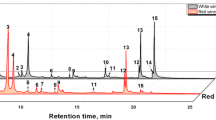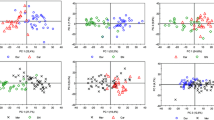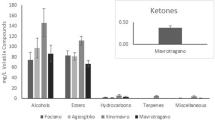Abstract
Prosecco wine is one of the most important products of the Italian oenological landscape. Its production is strictly regulated by several disciplinary. Thus, it is important to verify the quality of the final product, to defend the uniqueness of this wine. This work describes a rapid method to discriminate among varieties of Italian Prosecco wine using the volatile-fraction distribution as an untargeted fingerprint. The volatile profile corresponds to gas-chromatograms obtained in head-space mode. Principal components analysis of chromatograms allows discriminating the Prosecco samples depending on geographical origin, cultivation practices, and wine-making technologies. In particular, conventional vs. biological agriculture and manual vs. mechanical harvesting give well-separated clusters when projected on a scores plot. Influence plots allow evaluating which variables are the most effective to describe the differences between oenological classes, which are declared in the label and coded in the disciplinary of origin denomination. The identification of discriminating molecules in the volatile profile is also performed by Kovats indexes. Thus, possible chemical markers for the classification of Italian Prosecco wines are appointed.









Similar content being viewed by others
Availability of data and material
Data are not available.
References
González-Barreiro C, Rial-Otero R, Cancho-Grande B, Simal-Gándara J (2015) Wine aroma compounds in grapes: a critical review. Crit Rev Food Sci Nutr 55:202–218
Tomasi D, Gaiotti F, Jones GV (2013) The power of the terroir: the case study of prosecco wine. ISBN 9783034806282
Moret I, Scarponi G, Cescon P (1994) Chemometric characterization and classification of five Venetian white wines. J Agric Food Chem 42(5):1143–1153
Pisano PL, Silva MF, Olivieri AC (2015) Anthocyanins as markers for the classification of Argentinean wines according to botanical and geographical origin. Chemometric modeling of liquid chromatography-mass spectrometry data. Food Chem 175:174–180
Magdas DA, Guyon F, Feher I, Pinzaru SC (2018) Wine discrimination based on chemometric analysis of untargeted markers using FT-Raman spectroscopy. Food Control 85:385–391
Geana EI, Popescu R, Costinel D, Dinca OR, Ionete RE, Stefanescu I, Artem V, Bala C (2016) Classification of red wines using suitable markers coupled with multivariate statistic analysis. Food Chem 192:1015–1024
Francioli S, Torrens J, Riu-Aumatell M, López-Tamames E, Buxaderas S (2003) Volatile compounds by SPME-GC as age markers of sparkling wines. Am J Enol Vitic 54:158–162
Perestrelo R, Barros AS, Câmara JS, Rocha SM (2011) In-depth search focused on furans, lactones, volatile phenols, and acetals as potential age markers of Madeira wines by comprehensive two-dimensional gas chromatography with time-of-flight mass spectrometry combined with solid phase microextraction. J Agric Food Chem 59(7):3186–3204
Nasi A, Ferranti P, Amato S, Chianese L (2008) Identification of free and bound volatile compounds as typicalness and authenticity markers of non-aromatic grapes and wines through a combined use of mass spectrometric techniques. Food Chem 110(3):762–768
Fabani MP, Ravera MJA, Wunderlin DA (2013) Markers of typical red wine varieties from the Valley of Tulum (San Juan-Argentina) based on VOCs profile and chemometrics. Food Che 141(2):1055–1062
Disciplinare di Produzione dei Vini a Denominazione di Origine Controllata e Garantita “Conegliano Valdobbiadene - Prosecco.” pp 1–15
Disciplinare di Produzione della Denominazione di Origine Controllata dei Vini “Prosecco.”
Robinson AL, Boss PK, Solomon PS, Trengove RD, Heymann H, Ebeler SE (2014) Origins of grape and wine aroma. Part 1. Chemical components and viticultural impacts. Am J Enol Vitic 65:1–24
D’Onofrio C (2011) Caratterizzazione funzionale della biosintesi degli aromi delle uve durante lo sviluppo dell’acino e controllo della qualità aromatica delle uve. Italus Hortus 18:39–61
Noguerol-Pato R, González-Barreiro C, Cancho-Grande B, Simal-Gándara J (2009) Quantitative determination and characterisation of the main odourants of Mencía monovarietal red wines. Food Chem 117(3):473–484
Bosch-Fusté J, Riu-Aumatell M, Guadayol JM, Caixach J, López-Tamames E, Buxaderas S (2007) Volatile profiles of sparkling wines obtained by three extraction methods and gas chromatography-mass spectrometry (GC-MS) analysis. Food Chem 105(1):428–435
Cabrita MJ, Costa Freitas AM, Laureano O, Borsa D, Di Stefano R (2007) Aroma compounds in varietal wines from Alentejo, Portugal. J Food Compos Anal 20(5):375–390
Vilanova M, Sieiro C (2006) Determination of free and bound terpene compounds in Albariño wine. J Food Compos Anal 19(6-7):694–697
Marais J (2017) Terpenes in the aroma of grapes and wines: a review. S Afr J Enol Vitic 4(2):49–58
Chapman DM, Roby G, Ebeler SE, Guinard JX, Matthews MA (2005) Sensory attributes of Cabernet Sauvignon wines made from vines with different water status. Aust J Grape Wine Res 11:339–347
Belancic A, Agosin E, Ibacache A, Bordeu E, Baumes R, Razungles A, Bayonove C (1997) Influence of sun exposure on the aromatic composition of chilean Muscat grape cultivars Moscatel de Alejandria and Moscatel rosada. Am J Enol Vitic 48:181–186
Bureau SM, Razungles AJ, Baumes RL (2000) The aroma of Muscat of Frontignan grapes: effect of the light environment of vine or bunch on volatiles and glycoconjugates. J Sci Food Agric 80:2012–2020
Noguerol-Pato R, González-Rodríguez RM, González-Barreiro C, Cancho-Grande B, Simal-Gándara J (2011) Influence of tebuconazole residues on the aroma composition of Mencía red wines. Food Chem 124(4):1525–1532
González Álvarez M, Noguerol-Pato R, González-Barreiro C, Cancho-Grande B, Simal-Gándara J (2012) Changes of the sensorial attributes of white wines with the application of new anti-mildew fungicides under critical agricultural practices. Food Chem 130(1):139–146
González-Rodríguez RM, Noguerol-Pato R, González-Barreiro C, Cancho-Grande B, Simal-Gándara J (2011) Application of new fungicides under good agricultural practices and their effects on the volatile profile of white wines. Food Res Int 44(1):397–403
Pérez-Serradilla JA, de Castro MDL (2008) Role of lees in wine production: a review. Food Chem 111(2):447–456
Bueno JE, Peinado RA, Medina M, Moreno J (2006) Effect of a short contact time with lees on volatile composition of Airen and Macabeo wines. Biotechnol Lett 28:1007–1011
Bautista R, Fernández E, Falqué E (2007) Effect of the contact with fermentation-lees or commercial-lees on the volatile composition of white wines. Eur Food Res Technol 224(4):405–413
Olejar KJ, Fedrizzi B, Kilmartin PA (2015) Influence of harvesting technique and maceration process on aroma and phenolic attributes of Sauvignon blanc wine. Food Chem 183:181–189
Allen T, Herbst-Johnstone M, Girault M, Butler P, Logan G, Jouanneau S, Nicolau L, Kilmartin PA (2011) Influence of grape-harvesting steps on varietal thiol aromas in sauvignon blanc wines. J Agric Food Chem 59(19):10641–10650
Clary C, Steinhauer R, Frisinger J, Peffer T (1990) Evaluation of machine- vs. hand-harvested chardonnay. Am J Enol Vitic 41:176–181
Morris JR (1998) Factors influencing grape juice quality. HortTechnology 8(4):471–478
Carrara M, Catania P, Pipitone F, Vallone M, Salvia M (2007) Assessment of the pedicel detaching and crushing forces of grape berries to determine the optimal mechanical harvesting time. J Agric Eng 3:23–37
Pocock KF, Waters EJ (1998) The effect of mechanical harvesting and transport of grapes, and juice oxidation, on the protein stability of wines. Aust J Grape Wine Res 4(3):136–139
Pocock KF, Hayasaka Y, Peng Z, Williams PJ, Waters EJ (1998) The effect of mechanical harvesting and long-distance transport on the concentration of haze-forming proteins in grape juice. Aust J Grape Wine Res 4(1):23–29
Catarino S, Madeira M, Monteiro F, Rocha F, Curvelo-Garcia AS, De Sousa RB (2008) Effect of bentonite characteristics on the elemental composition of wine. J Agric Food Chem 56(1):158–165
Lira E, Salazar FN, Rodríguez-Bencomo JJ, Vincenzi S, Curioni A, López F (2014) Effect of using bentonite during fermentation on protein stabilisation and sensory properties of white wine. Int J Food Sci Technol 49(4):1070–1078
Molina AM, Swiegers JH, Varela C, Pretorius IS, Agosin E (2007) Influence of wine fermentation temperature on the synthesis of yeast-derived volatile aroma compounds. Appl Microbiol Biotechnol 77:675–687
Fraige K, Pereira-Filho ER, Carrilho E (2014) Fingerprinting of anthocyanins from grapes produced in Brazil using HPLC-DAD-MS and exploratory analysis by principal component analysis. Food Chem 145:395–403
Vaclavik L, Lacina O, Hajslova J, Zweigenbaum J (2011) The use of high performance liquid chromatography-quadrupole time-of-flight mass spectrometry coupled to advanced data mining and chemometric tools for discrimination and classification of red wines according to their variety. Anal Chim Acta 685(1):45–51
Villagra E, Santos LS, Vaz BG, Eberlin MN, Felipe Laurie V (2012) Varietal discrimination of Chilean wines by direct injection mass spectrometry analysis combined with multivariate statistics. Food Chem 131(2):692–697
Hermann G, Jaitz L, Schmölzer C, Koellensperger G, Eder R, Hann S (2012) Analysis of (poly-)phenols in commercially available red wines by means of LC-MS|Analyse von (Poly-)Phenolen in kommerziell erhältlichen Rotweinen via LC-MS. Mitteilungen Klosterneubg 62(1):13–20
Godelmann R, Fang F, Humpfer E, Schütz B, Bansbach M, Schäfer H, Spraul M (2013) Targeted and nontargeted wine analysis by 1H NMR spectroscopy combined with multivariate statistical analysis. Differentiation of important parameters: grape variety, geographical origin, year of vintage. J Agric Food Chem 61(23):5610–5619
Magdas DA, Cinta Pinzaru S, Guyon F, Feher I, Cozar BI (2018) Application of SERS technique in white wines discrimination. Food Control 92:30–36
de Almeida MP, Leopold N, Franco R, Pereira E (2019) Expedite SERS fingerprinting of Portuguese white wines using plasmonic silver nanostars. Front Chem 7:368
Bevin CJ, Dambergs RG, Fergusson AJ, Cozzolino D (2008) Varietal discrimination of Australian wines by means of mid-infrared spectroscopy and multivariate analysis. Anal Chim Acta 621(1):19–23
Banc R, Loghin F, Miere D, Fetea F, Socaciu C (2014) Romanian wines quality and authenticity using FT-MIR spectroscopy coupled with multivariate data analysis. Not Bot Horti Agrobot Cluj-Napoca 42(2):556–564
Culbert J, Cozzolino D, Ristic R, Wilkinson K (2015) Classification of sparkling wine style and quality by MIR spectroscopy. Molecules 20(5):8341–8356
Antoce AO (2012) Influence of maceration enzyme treatment on the colour and volatile profile of two red Romanian wines. Rev Chim 63(9):859–864
Antoce AO, Cojocaru GA (2015) Effects of blending and co-inoculation on the aromatic profile of wines. Rev Chim 66(10):1567–1571
Cojocaru GA, Antoce AO (2019) Influence of glutathione and ascorbic acid treatments during vinification of feteasca regala variety and their antioxidant effect on volatile profile. Biosensors 9(4):140
Arn H, Acree TE (1998) Flavornet: a database of aroma compounds based on odor potency in natural products. Dev Food Sci 40:27
R. Leardi, C. Melzi, G.P. CAT (chemometric agile tool). https://gruppochemiometria.it/index.php/software. Accessed Mar 2020
Bro R (2014) Principal component analysis. Anal Methods 6:2812–2831
Ballabio D (2015) A MATLAB toolbox for principal component analysis and unsupervised exploration of data structure. Chemom Intell Lab Syst 149:1–9
Mujica LE, Rodellar J, Fernández A, Güemes A (2011) Q-statistic and t2-statistic pca-based measures for damage assessment in structures. Struct Health Monit 10:539–553
Ballabio D, Consonni V (2013) Classification tools in chemistry. Part 1: linear models. PLS-DA. Anal Methods 5:3790–3798
Rottiers H, Tzompa Sosa DA, Van de Vyver L, Hinneh M, Everaert H, De Wever J, Messens K, Dewettinck K (2019) Discrimination of cocoa liquors based on their odor fingerprint: a fast GC electronic nose suitability study. Food Anal Methods 12:475–488
Frauendorfer F, Schieberle P (2006) Identification of the key aroma compounds in cocoa powder based on molecular sensory correlations. J Agric Food Chem 54(15):5521–5529
Fang Y, Qian M (2005) Aroma compounds in Oregon Pinot Noir wine determined by aroma extract dilution analysis (AEDA). Flavour Fragr J 20(1):22–29
Schieberle P (1991) Primary odorants of pale lager beer. Zeitschrift fǘr Leb Und-Forshcung 193:558–565
Buratti S, Benedetti S, Scampicchio M, Pangerod EC (2004) Characterization and classification of Italian Barbera wines by using an electronic nose and an amperometric electronic tongue. Anal Chim Acta 525(1):133–139
Schlesier K, Fauhl-Hassek C, Forina M, Cotea V, Kocsi E, Schoula R, van Jaarsveld F, Wittkowski R (2009) Characterization and determination of the geographical origin of wines. Part I: overview. Eur Food Res Technol 230:1
Antoce AO, Namolosanu I (2011) Rapid and precise discrimination of wines by means of an electronic nose based on gas-chromatography. Rev Chim 62(6):593–595
(2012) Regolamento di esecuzione (UE) N.203/2012 della commissione dell’8 marzo 2012. Gazz. Uff. dell’Unione Eur
Conlin AK, Martin EB, Morris AJ (2000) Confidence limits for contribution plots. Proc J Chemom 14:725–736
Riu-Aumatell M, Bosch-Fusté J, López-Tamames E, Buxaderas S (2006) Development of volatile compounds of cava (Spanish sparkling wine) during long ageing time in contact with lees. Food Chem 95(2):237–242
Santos AO, Wample RL, Sachidhanantham S, Kaye O (2012) Grape quality mapping for vineyard differential harvesting. Braz Arch Biol Technol 55:193–204
Arfelli G, Sartini E, Bordini F, Caprara C, Pezzi F (2010) Mechanical harvesting optimization and postharvest treatments to improve wine quality. J Int des Sci la Vigne du Vin 44(2):101–115
Funding
This research received no external funding.
Author information
Authors and Affiliations
Contributions
Conceptualization: FG, DM; methodology: FG; formal analysis and investigation: TF, AZ; writing—original draft preparation: TF, AZ; writing—review and editing: FG, DM; funding acquisition: FG; resources: FG; supervision: DM.
Corresponding author
Ethics declarations
Conflict of interest
The authors declare no conflict of interest associated with this publication.
Compliance with ethics requirements
This article does not contain any studies with human or animal subjects.
Additional information
Publisher's Note
Springer Nature remains neutral with regard to jurisdictional claims in published maps and institutional affiliations.
Rights and permissions
About this article
Cite this article
Forleo, T., Zappi, A., Gottardi, F. et al. Rapid discrimination of Italian Prosecco wines by head-space gas-chromatography basing on the volatile profile as a chemometric fingerprint. Eur Food Res Technol 246, 1805–1816 (2020). https://doi.org/10.1007/s00217-020-03534-8
Received:
Revised:
Accepted:
Published:
Issue Date:
DOI: https://doi.org/10.1007/s00217-020-03534-8




